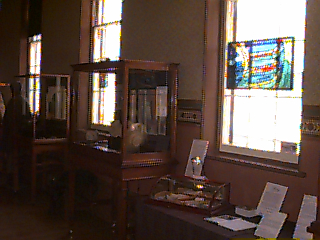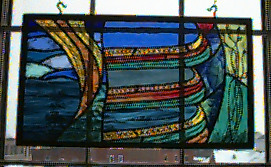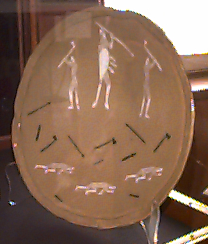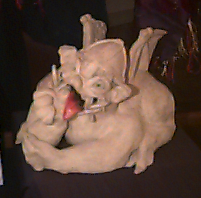



My journey in glass began 15 years ago working with nature designs acid etched onto clear glass and incorporated with dried seeds and glasses. Later I became fascinated by the intricacies and meditative qualities of traditional Celtic motifs. I have always been drawn to the rhythmic harmonies of geometric patterns which manifested itself in numerous Celtic works and in an ongoing series inspired by quilt designs. My interest in Celtic art, has developed through my involvement with An Droichead/The Bridge.
As I continued on my journey of exploration, I began to have a better understanding of glass as a medium. Stained glass is different from other art media in that it deals with transmitted light rather than reflected light. Because of its unique characteristics, a work of stained glass changes with the light coming through. Increasingly, I am being seduced by colour and I feel that learning about the interplay of colour, light and shadow will be a life long exploration. Colour and light affect us intensely. Marc Chagall, painter and stained glass artist, once commented that "Colour carries the emotional content of a work of art."
I first encountered the Bayeux Tapestry at an exhibition of the recreated tapestry worked by J. Raymond Dugan at the Southhampton Museum a few years ago. On that occasion I was fortunate enough to hear Mr. Dugan speak, which helped greatly to put the tapestry into its historical context. It is interesting to note that the time period in which the original Bayeux Tapestry was created is roughly contemporary with the dawn of stained glass in Europe. The tapestry commemorates the Norman conquest of Britain in 1066. The oldest complete stained glass windows still extant in Europe today are in Augsburg, Germany and were created in the late 11th century.
In my works inspired by the tapestry, I have used techniques which, with minor variations, would have been familiar to craftsmen of the Middle Ages. I have used lead came in the construction, rather than the more modern copper foil and solder technique which was first used in the 19th century. Many of the pieces are also painted and kiln-fired with glass enamels, again a technique already in general use in early stained glass windows. My general approach in creating the works for this exhibition has been to select strong visual elements from the tapestry and to slightly abstract them. The images are not in a literal context, rather they are like found fragments.
This panel draws its inspiration from the ranks of warriors holding heir shields while arrows fly overhead.

This piece shows the flotilla of Norman boats drawing towards the shores of Britain. I couldn't resist the billowing sail and the lines of the hulls clustered together.
Kevin became interested in historic reproductions when he started university in the late 80's. He has been actively creating objects based on those from the past for 12 years, focusing mainly on 14th C France and 10th C Norse cultures. He has worked as an interpreter at a living history museum and was a guest re-enactor at L'Anse aux Meadows / Norstead for the 1000-year celebrations. His interest in producing pieces is grounded in trying to also discover the techniques and tools used as well as a finished product. The materials Kevin usually work with, (but is hardly limited to) are: steel / bronze / pewter / wood / cloth / leather, and most recently bone.
"While looking at photographs of the Bayeux tapestry, I noticed some of the figures with belts. This inspired me to look up some common articles that people could have carried with them. Bone is a relatively new medium to me, but it is something that has been available at least since livestock was domesticated, probably earlier. As a medium, it is wonderful to work with. Hard, strong, and flexible, the first "plastic" material. Being organic, it also has a wide range of variability, as the trial attempts attest to. The three cultures that converged in 1066 AD all had access to bone as a medium, as the archaeological records document. Although the pieces reproduced here are based on artifacts found at Jorvik (Viking Age York), all would not have looked out of place, mundane even, worn or carried by a Norman or Saxon."
What soldier doesn't trust his luck when it comes to battle? Dice have been found in graves and archeological sites since Roman times and basically have not changed since then. The ring dot motif was made with a ring dot tool and bow drill.
This clothing accessory would not have been worn by a nobleman; they would have purchased a silver or bronze buckle and strap-end instead. The surface of the buckle lacks ornamentation, and waits to be carved. (Perhaps on the voyage across the channel?) The strap-end, made of pewter (modern lead-free alloy) was produced in the mold described below. The pattern is very similar to an artifact found at Jorvik (York, England). The knotwork shows the influence earlier cultures (Celtic) had on the Norse. The buckle and strap-end were sewn on to be consistent with the modest lifestyle of the wearer.
Steatite is a soft material that can be easily carved, and withstands moderate amounts of heat. Molds of this type would have produced items intended for mass consumption. The design for this object is taken from an existing strap end (see description above) then 'working backwards' to create the required mold.
Hygiene and grooming was an important aspect of Norse culture. As such, an implement to keep those unwanted hairs at bay would have been handy. The scoop on the other end was used to scrape the ears free of wax (or so the literature tells me). Ring dot motif on the tweezers' limbs with a spiral filed into the handle.
Skates were an efficient means of transportation during the winter month along frozen river and lakes. They would have been used with one or two iron tipped poles. I find two poles to be easier, like skiing and less tiring to use. Although you do not glide as much as modern steeled skates, the bones keep your feet off the ice. This pair is made of deer bones. More typically the skates would have been made from horse. In earlier prototypes, cattle were also used, but I have found the modern breeds to have bones too large to use for this purpose.
Since 1983, Rosemary has operated a personal home based studio in the Shelburne area, firing porcelain & stoneware in oxidation to 'cone 6' temperatures. "As a decorative, functional potter I am interested in the exploration of different surface treatments using clay slip, stencils & sgraffito. My use of stylized, naive decoration in neutral tones on a simple form is an attempt to make pieces that are able to establish an emotional link with the viewer. My work is influenced by ritual, history & everyday life.
"Reflections of the Conquest gives me a whole new era to explore. The Bayeux Tapestry is made up of beautiful scenes, replete with details of everyday life and the preparations for war as well as the act of war itself. This imagery has inspired pieces using the attractive figures as stencils both positive and negative. These figures of great beauty help humanize history and allow us to feel more a part of long ago occurrences; history is brought to life."

This slab and coil constructed piece shows stages of the battle. The faintly striated rim shows the wave action of the invading Norman troops. Three figures fight, three figures lie dead surrounded by weapons. The underside shows one dead soldier & many implements of destruction. This flat footed bowl also brings to mind an archaeological dig with layers of the living, the weapons & the dead.
Figures fight & die on this wheel thrown vase with a foreground line joining men & animals together. My research did not reveal any concrete figure for the number of dead from this battle although thousands were mentioned.
Two soldiers lie still fully clothed before human jackals creep forward to strip them of anything of value. In the brown slip on this wheel thrown piece, weapons & circles reminiscent of the chain mail armour surround them.
Elizabeth studied fine art and mediaeval history, literature and languages at the University of Toronto. After graduation, she made her living as a printmaker, drawing on her mediaeval studies for theme and subject, until 1982. Her other interests in the Middle Ages include spinning, textile production, embroidery, dyes, manuscript illumination and herbology, all fostered by a twelve-year stint in the Society for Creative Anachronism.
In 1992, after moving to Northern Ontario, Elizabeth became involved with clay. She currently owns and operates Hedgehog Ceramics, and writes on shepherding, folklore and assorted other subjects for print and radio. Elizabeth lives in Wharncliffe, Ontario, with her husband, David Syme, a dog, five cats and an awful lot of sheep. She makes her living as a potter, writer, spinner and teacher, and seriously believes that too much housework rots the soul.

While major sculptures or paintings for church use were reserved for religious, didactic or allegorical depictions of a serious and reverent nature, the "marginalia" of architecture could be used to make social or political comment of a less dignified sort. These marginal features included misericordes, gargoyles and "grotesques" - often pagan or mythological figures. No detail of domestic life, sex or scatology was too outre for these marginalia.
This gargoyle is conceived as a commentary on the unpopularity of William the Conqueror's Domesday Book, a census of the lands, buildings and other assets of England. The Peterborough Monk, who wrote of WIlliam's reign, said of the Domesday Book : "It is shameful to think, but it was not shameful to him to do it." The Domesday Book was, of course, a way of keeping track of who might owe what monies and services to the king, and was greeted with all the enthusiasm historically afforded such government efforts. I have therefore shown WIlliam as I imagine he might have been seen in some inconspicuous corner of an out-of-the-way church, gobbling up the English and excreting the Domesday Book.
